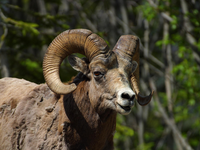Sheep
A sheep is any of member of the eight wooly quadruped species that comprise the genus Ovis, part of the goat antelope subfamily. The domestic sheep is thought to be descended from the wild moufflon of central and southwest Asia. more...
Male sheep are called rams, females ewes, and young lambs. Members of the genus are highly gregarious bovids (members of the family Bovidae) and ruminants, meaning they chew cud.
Sheep are usually stockier than other bovines, and some have horns which are more more divergent than those of goats. Sheep have scent glands on the face and hind feet. Communication through the scent glands is not well understood but is thought to be important for sexual signaling. Males can smell females which are fertile and ready to mate, and rams mark their territories by rubbing scent on to rocks. They have a four-chambered stomach which play a vital role in digesting, reguritating, and redigesting food. Domestic sheep are important for their wool, milk, and meat (which is called mutton or lamb).
Sheep species
There are at least eight species of sheep:
Hybrids with goats
Although sheep and goats seem similar and can be mated together they belong to different genera. Goats are caprinae and have 60 chromosomes while sheep are ovinae and have 54 chromosomes. At Botswana Ministry of Agriculture, a ram that was kept with a nanny goat impregnated the goat resulting in a live offspring that had 57 chromosomes. This was called "The Toast of Batswana". The hybrid is intermediate between the two parent species in type. It has a coarse outer coat, awoolly inner coat, long goat-like legs and a heavy sheep-like body. Although infertile, the Toast of Batswana was castrated to prevent unwanted sexual behaviour because it continually mounted the sheep and goats sharing its enclosure.
In 1969, Australian farmer Dick Lanyon, who farmed near Melbourne, Australia, kept a billy-goat among his sheep to scare off foxes during the lambing season. In September of the same year, he claimed to have dozens of ‘lambs’ which were sheep-goat hybrids. The goat was locked up while scientists examined the supposed hybrids. As no more was heard of this case, it is believed that the lambs were pure-bred sheep.
There is a long-standing belief in sheep/goat hybrids which is due to the animals' resemblance to each other. Some primitive varieties of sheep may be misidentified as goats. In "Darwinism An Exposition Of The Theory Of Natural Selection With Some Of Its Applications" (1889), Alfred Russel Wallace wrote:
- the following statement of Mr. Low: "It has been long known to shepherds, though questioned by naturalists, that the progeny of the cross between the sheep and goat is fertile. Breeds of this mixed race are numerous in the north of Europe." Nothing appears to be known of such hybrids either in Scandinavia or in Italy; but Professor Giglioli of Florence has kindly given me some useful references to works in which they are described. The following extract from his letter is very interesting: "I need not tell you that there being such hybrids is now generally accepted as a fact. Buffon (Supplements, tom. iii. p. 7, 1756) obtained one such hybrid in 1751 and eight in 1752. Sanson (La Culture, vol. vi. p. 372, 1865) mentions a case observed in the Vosges, France. Geoff. St. Hilaire (Hist. Nat. Gén. des reg. org., vol. iii. p. 163) was the first to mention, I believe, that in different parts of South America the ram is more usually crossed with the she-goat than the sheep with the he-goat. The well-known 'pellones' of Chile are produced by the second an third generation of such hybrids (Gay, 'Hist, de Chile,' vol. i. p. 466, Agriculture, 1862). Hybrids bred from goat and sheep are called 'chabin' in French, and 'cabruno' in Spanish. In Chile such hybrids are called 'carneros lanudos'; their breeding inter se appears to be not always successful, and often the original cross has to be recommenced to obtain the proportion of three-eighths of he-goat and five-eighths of sheep, or of three-eighths of ram and five-eighths of she-goat; such being the reputed best hybrids."
Supposedly, most goat-sheep hybrids die as embryos (the famous geep is a chimera, not a hybrid). Hybrid male mammals are often sterile due to a phenomenon called Haldane's Rule. The Haldane phenomena may apply even when the parent species have the same number of chromosomes as in most cat species hybrids. It sometimes does not apply when the species chromosome number is different as in wild horse (chromosome number = 66) and domestic horse (chromosome number = 64) hybrids. Hybrid female fertility tends to decrease with increasing divergence in chromosome similarity between parent species. Presumably, this is due to mismatch problems during meiosis and the resulting production of eggs with unbalanced genetic complements.
Read more at Wikipedia.org




